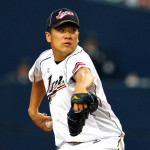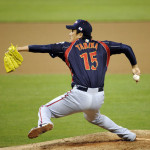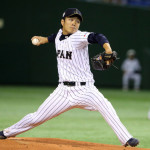I was not privy to observing all of the games, nor all the Japanese pitchers who applied their skills in the dominance of the Major-League batters during the Japanese Baseball Series. But what I was able to perceive during a few of the games was the masterful body-mechanics with which the Samurai “Mounds-men” displayed ultra-functional speed and control to over-power and confuse their opponents with pitches of intense velocity, uncanny control, and proficient variations of speed and subtle directional deviations from a straight line.
The U.S. Team, most batters of which held their bats high, stood tall, and practiced a lengthy stride or high leg kick, had very little chance of adjusting to the multiples of off-speed pitches and blazing fast-balls of the Samurai “warriors.” Occasionally a “powerfully built” MLB player would hit a Home-Run while correctly guessing fast-ball, but the astute Japanese pitchers would not usually make the same mistake twice.
The batting mechanics of the Japanese players were not any better than the MLB players, but the Samurai mental attitude and approach to hitting were obviously more productive than were those of the U.S. Although the flaws in each team’s batting mechanics were similar, the aggressive Japanese approach was more rational.
Since most pitchers are anxious to begin with a first-pitch strike, a fastball is normally the order of the at-bat. And of course, most MLB batters portend to apply the “Mike Trout” approach to hitting by taking one or two fast-ball strikes (right down the middle), then, against mediocre pitching, resign themselves to being good 2-strike hitters (hopefully). Meanwhile, the smaller and seemingly less-powerful Japanese hitters were “jumping” all over every first fast-ball strike (any strike) they saw, and blasting it for extra-bases.
All things being relatively equal in the department of “Batting Mechanics,” the Japanese had proven themselves to be superior in the realms of “smart-hitting-approach.” Although both teams were similar in the area of Pitching Mechanics, the Japanese were closer to “flawless” technique.
Americanized Baseball players are reluctant to become exact replicas of a previously established super-star, because they prefer to establish their own unique and distinguished style of batting or pitching “technique.” Otherwise every batter would or should copy the batting technique of Barry Bonds. (I haven’t seen another BARRY.)
But look at the Japanese! Almost every one of their batters is still trying the replicate the batting style of their ancient hero, Sadaharu Oh. But even Sadaharu’s high leg-kick wouldn’t do well against the master-pitching technicians of the modern era, especially in his native land.
And look at all these young pitchers, especially Norimoto! Even their left-handers have the same anatomically and physiologically correct body-mechanics and arm-motion as Masahiro Tanaka.

 Whoever it is that is perpetuating the imperfect batting-mechanics of the distant past should start thinking “outside the box,” like whoever it is/was that was the vanguard for the innovative thinking that produced the likes of Masahiro Tanaka, Takahiro Norimoto, and others who have become the new standard for Pitching Excellence. (Maybe some fortunate Japanese pitching aspirant wandered into the instructional Pitching Camp of Resident Arizona Pitching Guru, Dick Mills, and learned a few things about Pitching Conditioning and Mechanics!)
Whoever it is that is perpetuating the imperfect batting-mechanics of the distant past should start thinking “outside the box,” like whoever it is/was that was the vanguard for the innovative thinking that produced the likes of Masahiro Tanaka, Takahiro Norimoto, and others who have become the new standard for Pitching Excellence. (Maybe some fortunate Japanese pitching aspirant wandered into the instructional Pitching Camp of Resident Arizona Pitching Guru, Dick Mills, and learned a few things about Pitching Conditioning and Mechanics!)
Coming Next: Breakdowns of Correct Batting and Throwing Mechanics.